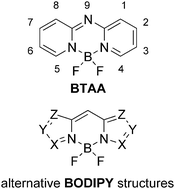Difluoro-boron-triaza-anthracene: a laser dye in the blue region. Theoretical simulation of alternative difluoro-boron-diaza-aromatic systems†
Abstract
The synthesis, photophysical and laser properties of a difluoro-boron-triaza-

* Corresponding authors
a
Departamento de Química Física, Universidad del País Vasco-EHU, Apartado 644, 48080-Bilbao, Spain
E-mail:
fernando.lopezarbeloa@ehu.es
Fax: +34946013500
Tel: +34946015971
b
Instituto de Ciencia y Tecnología de Polímeros, CSIC, Juan de la Cierva 3, 28006-Madrid, Spain
E-mail:
martaliras@ictp.csic.es
c
Instituto de Química-Física “Rocasolano”, CSIC, Serrano 119, 28006-Madrid, Spain
E-mail:
acostela@iqfr.csic.es
The synthesis, photophysical and laser properties of a difluoro-boron-triaza-

 Please wait while we load your content...
Something went wrong. Try again?
Please wait while we load your content...
Something went wrong. Try again?
J. Bañuelos, F. L. Arbeloa, V. Martinez, M. Liras, A. Costela, I. G. Moreno and I. L. Arbeloa, Phys. Chem. Chem. Phys., 2011, 13, 3437 DOI: 10.1039/C0CP01147A
To request permission to reproduce material from this article, please go to the Copyright Clearance Center request page.
If you are an author contributing to an RSC publication, you do not need to request permission provided correct acknowledgement is given.
If you are the author of this article, you do not need to request permission to reproduce figures and diagrams provided correct acknowledgement is given. If you want to reproduce the whole article in a third-party publication (excluding your thesis/dissertation for which permission is not required) please go to the Copyright Clearance Center request page.
Read more about how to correctly acknowledge RSC content.
 Fetching data from CrossRef.
Fetching data from CrossRef.
This may take some time to load.
Loading related content
